
•Year started : 2006
•Location : 26 districts (111 hectares) in Shiga Prefecture (as of fiscal 2009)
•Actor : Shiga Prefecture
The rice paddies surrounding Lake Biwa in Shiga Prefecture were once important spawning and breeding sites for lake fish, including carp, crucian carp and Nigorobuna. However, the area was at a great disadvantage in terms of agriculture because it was vulnerable to the fluctuating water level of Lake Biwa and farmers suffered damage from flooding. Furthermore, because rice was grown in wet paddies, farmers had to use flat-bottomed boats. From the 1960s to the 1970s, land consolidation projects were promoted and paddies were reorganized into larger dry fields. This increased yield significantly, but cut off channels for fish and other aquatic organisms to migrate between Lake Biwa and the paddies, therefore diminishing the paddies' function as a habitat for fish to spawn, breed and develop. Intrusions by exotic fish species have also contributed to the drastic decrease of native fish, in particular, the Nigorobuna carp, an endemic species to Lake Biwa and an essential ingredient in the traditional local dish, "Funazushi." The Nigorobuna carp population has decreased to one-tenth of what it was 40 years ago.
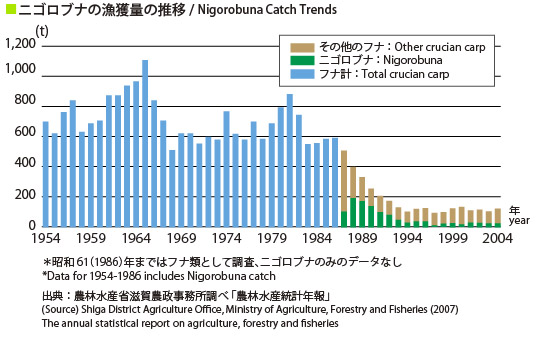
Against this backdrop, Shiga Prefecture has promoted the installation of fishways in order to let fish move freely between Lake Biwa and rice paddies, thereby restoring the traditional function of rice paddies to provide habitat for spawning and breeding.
In 2001, an ecosystem survey conducted on the functions of a rice paddy in terms of fish spawning and breeding revealed that rice paddies are shallow and can maintain just the right temperature suitable for spawning and hatching. Furthermore, they are free of predators such as black bass; therefore, the survival rate of hatchlings proved to be 30 percent, which is higher than that in the stretch of reed along Lake Biwa. Because rice paddies are abundant in plankton, the hatchlings, which feed on plankton, quickly grew to be two centimeters in length and capable of swimming in approximately one month.
In 2004, residents were invited to jointly make fish ladders, which are like stairways, or a series of low steps, in the drainage canals, with each step measuring 10 centimeters in height, elevating until the water in the fishway is level with the lake water. The fish ladders were made of forest trimmings.
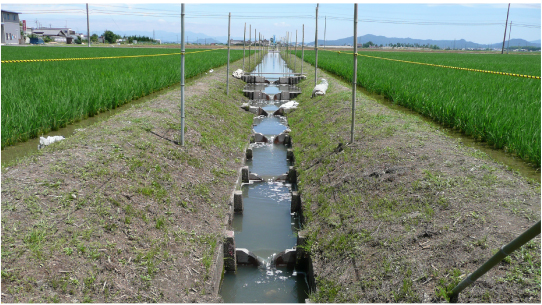
Photo: Fish ladder ©Shiga Prefecture
In 2006, Shiga Prefecture implemented a project (Pilot Program for Direct Environmental Payments for Fish Cradle Rice Paddies) for direct environmental payments of 3,500 per 1,000 square meters to groups that engage in the water management and maintenance of the fishways required for fish to run up the river to spawn and for hatchling to develop in addition to conventional agricultural activities. From the following year, the program has been continued under a national program (Measures to Conserve and Improve Land, Water and Environment)[1] which grants 4,400 yen per 1,000 square meters.
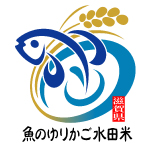 As a supportive measure for farmers engaging in this effort, Shiga
Prefecture also certifies rice produced in "fish cradle" rice paddies
as Fish Cradle Rice. The logo design was selected in 2007 from
ideas submitted by citizens and applied for trademark registration
in 2009.
As a supportive measure for farmers engaging in this effort, Shiga
Prefecture also certifies rice produced in "fish cradle" rice paddies
as Fish Cradle Rice. The logo design was selected in 2007 from
ideas submitted by citizens and applied for trademark registration
in 2009.
To be entitled to use the trademark, rice farmers must comply with
the following conditions:
1) Pesticides with the lowest level of fish toxicity are used in the
fields and the water valves are closed so as to control water flow
for a few days after application to keep chemicals from flowing out of the rice fields and
prevent fish from entering the fields.
2) Rice fields are properly managed so that fish habitats are not affected.
3) Efforts are made to enable hatchlings to move out from the paddies to the channels
before draining the fields.
4) Rice paddies are home to native fish species that run up the fishways set up in the
drainage canals to spawn.
The prefecture also encourages farmers to acquire the Environmentally Friendly Product [2] seal, a separate certification program operated by the prefectural government criteria, although not a requirement for using the Fish Cradle Rice trademark. As a result, 100 percent of the rice sold under the Fish Cradle Rice label has been certified as Environmentally Friendly Rice. Thus the rice is grown with 50 percent reduced agrichemicals and with herbicides of low fish-toxicity, applying biodiversity-friendly agricultural methods.
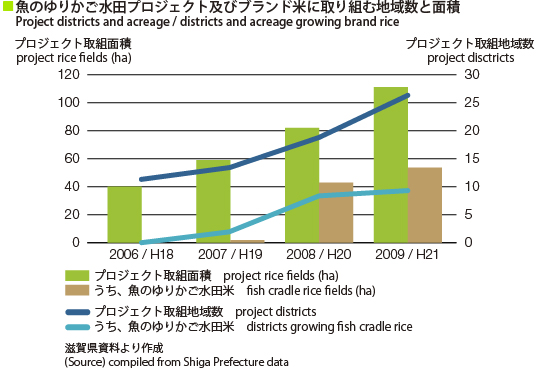
Fish Cradle Rice has been sold for a higher price than rice grown by conventional methods
[3] (figure below). Beginning with rice harvested in 2008, it has been selling in major
supermarkets in Shiga Prefecture for a premium price.
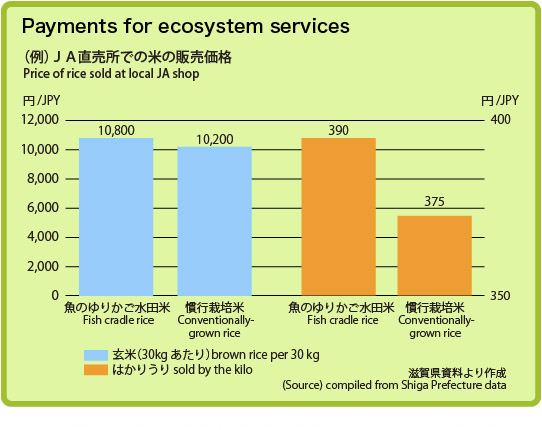
As a result of taking part in the Fish Cradle Rice Paddies project, farmers say that they were able to rediscover the strong relationship between Lake Biwa and surrounding rice paddies upon seeing the hatchlings swim out to the lake. The rice paddies have also provided a source for environmental education sessions given to elementary school children. More acreage has become dedicated to Environment-Friendly rice in each district and has led to an increasing number of local efforts to promote agriculture and conserve the environment.
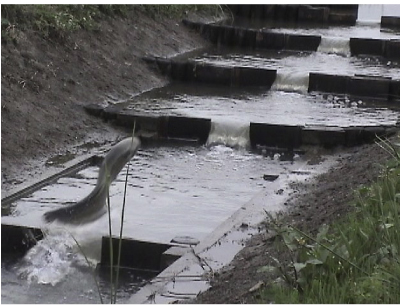
Photo: catfish running up the fishway © Shiga Prefecture
[1] The Measures to Conserve and Improve Land, Water and Environment program was launched in
2007. It consists of two types of subsidies: one to support cooperative rural resource management
activities and one to support environment-friendly agriculture. Subsidies can only be granted to
organizations comprising not only farmers but also other various actors of a rural community.
[2] The requirements for certification under the Environmentally-Friendly Product program are to: 1)
reduce use of chemical fertilizers and pesticides by 50 percent or more compared to conventional
farming methods: 2) apply agricultural methods that are friendly to Lake Biwa and the surrounding
environment; 3) keep a record of the when and which agrichemicals are used
Agricultural methods using a standard amount of agricultural pesticides and chemical fertilizers as
stipulated in regional guidelines determined by the local government.
•References
· Shiga Prefecture (2006) Shiga Prefecture Nigorobuna Resources Restoration Plan
· Shiga Prefecture, Vigorous Community Promotion Office, Rural Development Promotion Division,
Department of Agriculture and Fisheries “Fish Cradle Rice Paddy Project: Restoring a rice paddy
environment for lake fish to spawn and breed”: www.pref.shiga.jp/g/noson/fish-cradle/index.html (last
accessed August 31, 2010) (available in Japanese only)
· Terabayashi, Akira (2010) “Restoring the environment and local community through “Fish Cradle Rice
Paddies”: JA Green Omi and Kurimidezaike-cho” Chosa to Joho, Tokyo: Norinchukin Research Institute
(only available in Japanese)
•Special thanks to
Shiga Prefecture (Vigorous Community Promotion Office, Rural Development Promotion Division,
Department of Agriculture and Fisheries)

